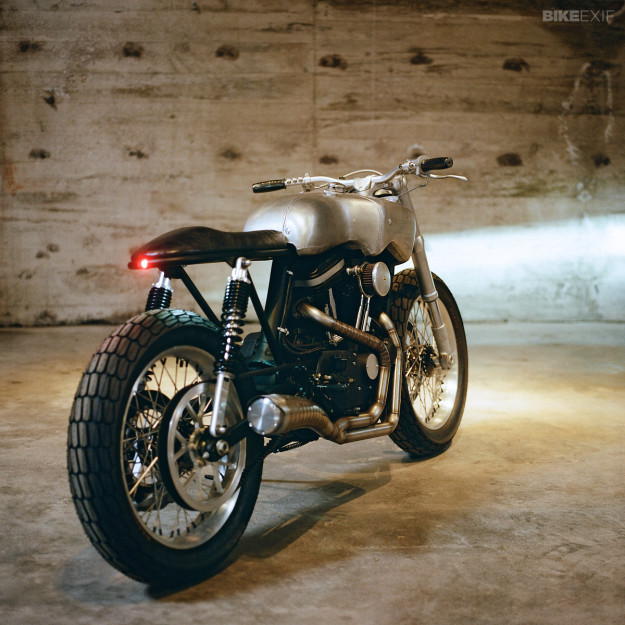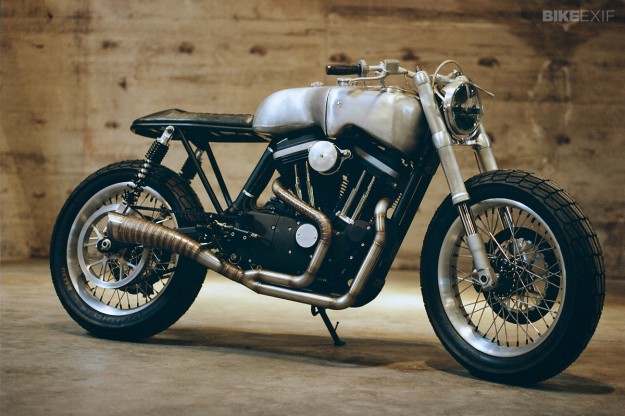
Revival Cycles are known mostly for their show-stopping Moto Guzzi customs. So it should feel strange to see a Harley roll out of the Texas workshop. But somehow, it doesn’t: this Sportster 883 is exactly what you’d expect from Alan Stulberg and crew when it comes to style and quality.
The story of ‘Hardley’ is a long one. The project kicked off over two years ago when the 883’s owner spotted a few Revival builds floating around. So he called up Stulberg and asked him if Revival would take on his Harley. “Tony seemed adamant that we could turn it into something special, and still a ‘Revival’ bike,” says Stulberg, “I’ll admit that I had my doubts.”
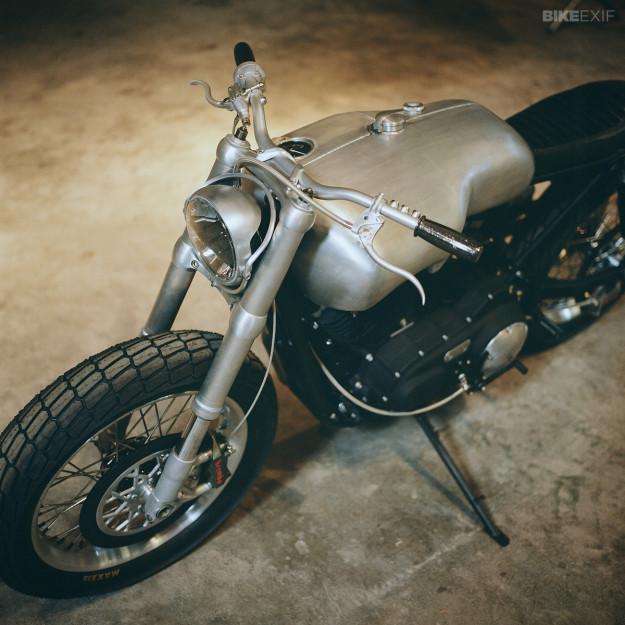
Tony offered free reign though, and this was enough to motivate Revival Cycles to take on the build. “Just to see what we could do”. Revival decided to focus on what they saw as the Harley’s biggest strength: its heritage, defined by that big V-twin engine. Everything in the design would serve to accentuate the V configuration: “As if everything else was simply minimized to serve the engine shape,” says Stulberg. “If you look hard enough, you’ll see the V shape on everything from the bespoke handlebar clamp to the fuel tank profile that plunges into a V between the cylinders.”
After stripping down the 883, Revival realised just how heavy the stock bike was. Weight saving was not a priority, but the finished bike weighs in at almost 102lbs less than stock. Custom 19” wheels were built up and a new rear loop made to accommodate a café-style seat. And then the project stalled—Tony decided that he wanted a two-up arrangement instead. “A simple change of tank, seat and wheels ended up becoming an entirely different animal,” says Stulberg.
“We felt inspired by just how far this bike could go if the budget, timeline and limitations were thrown out the window. We pitched it to Tony,” says Stulberg. “We wanted to build this machine into something that would make us envious.” Tony agreed—but asked Revival to shelve the bike until he’d had a chance to sort out other business.

Roughly a year later he returned with his pocketbook and planning began anew. The 19” wheels would be kept, but a host of already-purchased aftermarket parts were tossed, along with the Harley’s original suspension. “This bike would now need proper suspension to match what was coming.”
What was coming was a significant increase in power. “The 883 engine numbers simply weren’t gonna cut it,” says Stulberg. Although the donor bike only had 450 miles on it, Revival tore into it with a 1250cc cylinder and piston kit, Harley’s own 1200cc heads (with larger valves and ports) and an ECU with custom mapped fuel injection. The numbers are much better now: 100bhp and 100Nm. “It’s wicked fast compared to how it all began.”
Then Revival turned to this Sportster’s most distinguishing feature—a completely bespoke, three-piece aluminum fuel tank. Built as a single unit before being divided into three sections, it now carries three gallons of fuel in the left half, with oil in the right rear quarter and the electronics in the right front quarter. Fuel capacity is the same as a stock Sportster 883, and the oil tank portion is double-walled to keep it cool against the rider’s leg.
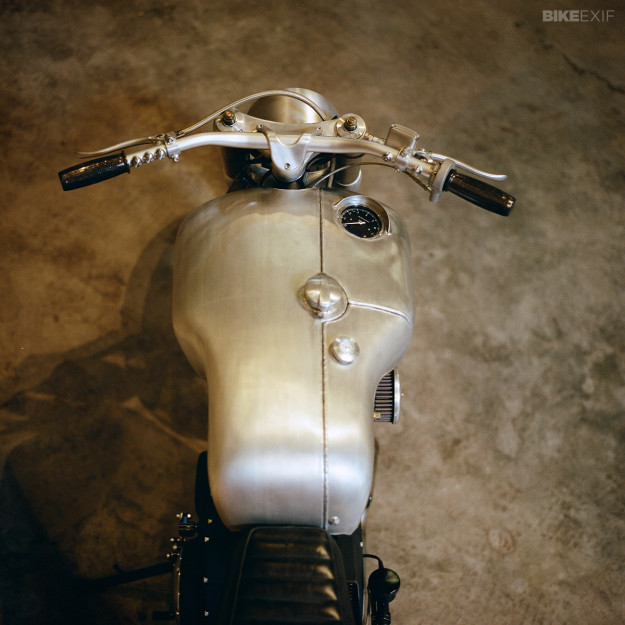
Revival know their way around a bike’s electrical system, and are devout users of Motogadget products. The electronics section of the tank not only houses the Motogadget Chronoclassic speedo, but also a Motogadget m-Unit electrical system controller, a lithium-Ion battery and the ECU. “Plus about 98% of the new made-from-scratch wiring harness,” Stulberg adds.
The space for the new electronics is about the same size as an average motorcycle’s battery box, and significantly lighter than the stock arrangement. As an added bonus, all three sections of the new ‘tank’ are easily removable via quick-turn fasteners.
Revival then wrapped the 19” wheels in popular Maxxis dirt-track rubber. “They’re sticky as hell and will provide excellent traction on any surface. They won’t last long, but we didn’t build this thing for touring, we built it for serious abuse. And that means a tire replacement now and then.”
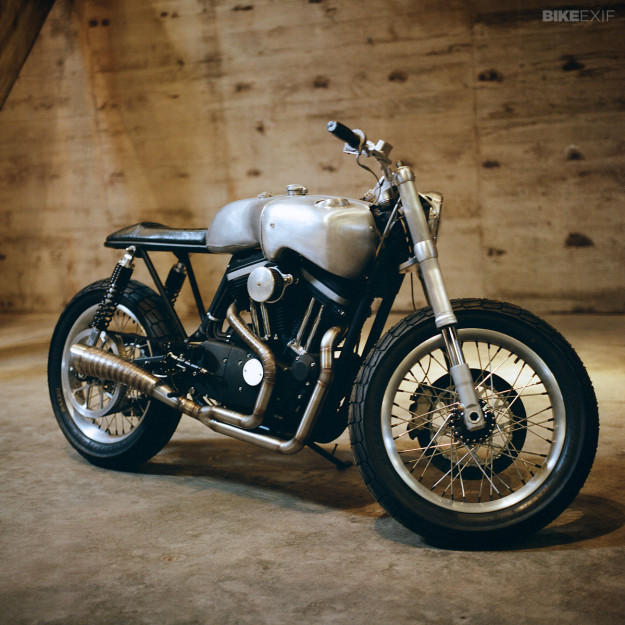
The tyre and wheel choice influenced much of the remaining styling considerations. For one, Revival wanted the bike to sit taller, with a more aggressive stance. So they sourced stronger and taller upside-down forks from a Kawasaki ZX-14, and matched them to custom-built shocks from Ikon. Both the forks and shocks are fully adjustable. Revival altered the geometry too—running simulations and calculations before fabricating custom triple trees. The handlebar clamp is now integrated into the top clamp: “It appears as if it was sculpted from one single piece, as intended.”
For the braking system, Revival took the time to source new technology rotors that are made from an alloy and ceramic composite, making them lighter and more resistant to brake fade. These were paired with Brembo monobloc calipers and custom-built stainless steel brake lines. Alan reports that the setup works well: “The intense feel and control given from the combination of these brakes and the sticky tires is simply amazing.”
The 883’s belt drive was retained. Revival mounted a blank rear pulley, then CNC-milled it to match the shape of the rear brake rotor. Belt tension became an issue though, due to the bike’s additional suspension travel. So a custom spring-loaded idle arm was made, to ride on the belt and keep it taut.
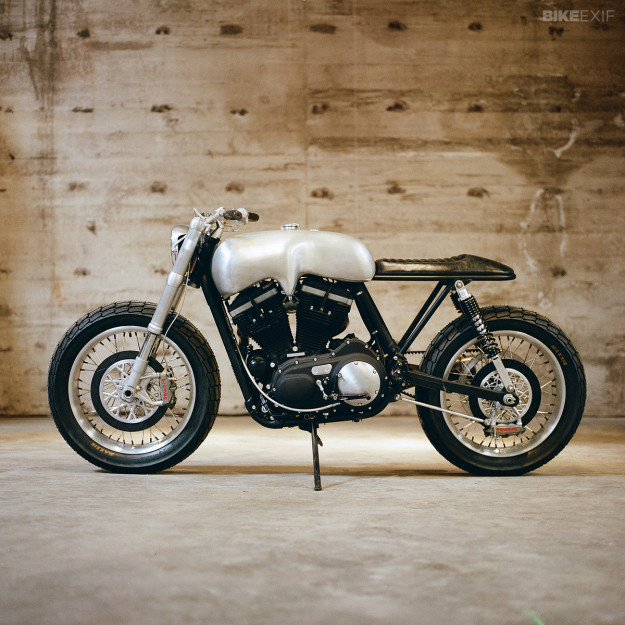
In keeping with the raw, hand-made feel of the rest of the bike, a full stainless steel exhaust system was made up, including a custom-tuned silencer with SuperTrapp internals. “This is a very quiet Harley at a stop light and as loud as any under full throttle.”
Revival also built a new, lightweight chromoly subframe, supporting a distressed leather seat made by Ginger at New Church Moto. “Everything else on the bike was done in-house at Revival, but nobody does leather work better than Ginger.” Undecided about the two-up seat, Alan says that they’re “Likely going to build an easily removable second seat that would have an aluminum cowl”. To this end, the passenger foot pegs are removable.
Finishing kit includes a LED headlight in an aluminum housing, a LED tail light embedded in the new subframe, rearsets by Sato, Posh grips and new switchgear integrated into the handlebars.
Revival have succeeded in building a bike that’s not only beautiful to look at, but loaded with technical features. And why the name ‘Hardley’?
Alan says it’s because it’s “hardly in the same league as its previous self.”
I couldn’t have put it better myself.
All images by Alan Stulberg, shot with a Hasselblad on medium format film. Keep in touch with Revival Cycles via their website or Facebook page. Our archive of previous Revival builds is here.
